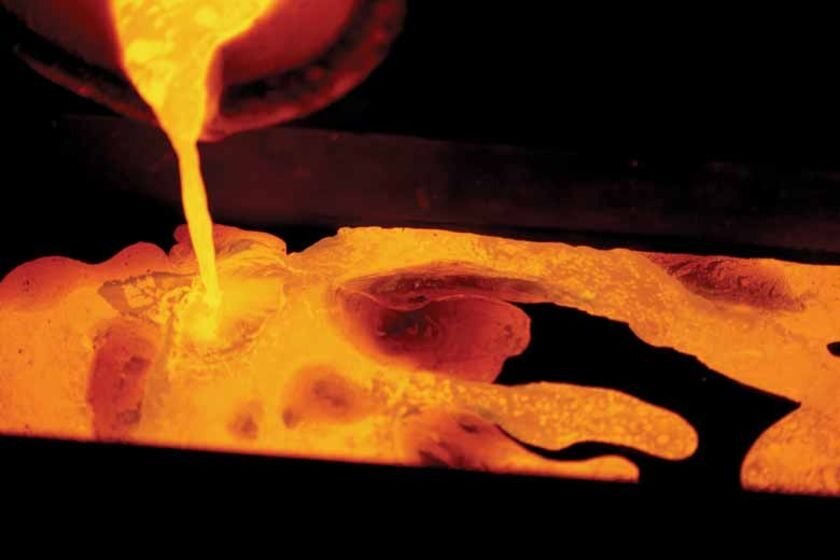List of Minerals
This list provides an overview of minerals. Minerals can be organized, mainly according to their chemistry, into the following classes:
| CLASS | Consisting of: |
| Carbonates | The Carbonates, the Nitrates and the Borates |
| Elements | The Metals and their alloys and the Nonmetals |
| Halides | The Fluorides, the Chlorides and the Iodides |
| Oxides | The Oxides and the Hydroxides |
| Phosphates | The Phosphates, the Arsenates, the Vanadates and the Antimonates |
| Silicates | The Silicates (the largest class) |
| Sulfates | The Sulfates, the Sulfites, the Chromates, the Molybdates, the Selenates, the Selenites, the Tellurates, the Tellurites and the Tungstates (or the Wolframates) |
| Sulfides | The Sulfides, the Selenides, the Tellurides, the Arsenides, the Antimonides, the Bismuthinides and the Sulfosalts |
The majority of the around 5,650 mineral types known today and recognized as independently by the International Mineralogical Association (IMA) (as of 2020) are inorganic , but some organic substances such as mellite and evenkite or the kidney stone formers whewellite and weddellite are also recognized as minerals because they also form in the wild. Including all known mineral varieties and synonyms However, there are more than 6,800 mineral names (as of 2018/19), names (approx. 1200) and not yet recognized mineral types (approx. 120).
Classification of minerals
Silicates Minerals
Silicates and the various forms of silica attached to them have considerable industrial and geochemical significance. Silicates are salts or esters of silica (H 4 SiO 4 ). The salts all contain the tetrahedral SiO 4 4− ion (or a derivative thereof, with one or more hydrogen atoms). Silicates are used as raw materials in the preparation of glass . The silicates of sodium and calcium are called water glass and have applications in the art.
The Silicates are divided into the following subclasses, not by their chemistries, but by their structures:
- Nesosilicates (single tetrahedrons)
- Sorosilicates (double tetrahedrons)
- Inosilicates (single and double chains)
- Cyclosilicates (rings)
- Phyllosilicates (sheets)
- Tectosilicates (frameworks)
| Silicates | |||||
|---|---|---|---|---|---|
| Nesosilicates | Tectosilicates | Phyllosilicates | Inosilicates | Sorosilicates | Cyclosilicates |
|
|
|
|
|
|
Oxides, Sulphides, Sulphates, Phosphates, Carbonates, Borates, Tungsten, Molybdates
- Oxides: In inorganic chemistry , an oxide is a compound between another element and oxygen in which oxygen acts as an oxidizer and assumes the oxidation state −2 (O 2− ). Many oxides are black but others can be very colorful. The large diversity of oxides can be partially attributed to the extreme abundance of oxygen in the Earth’s crust. Oxygen comprises over 45% of the Earth’s crust by weight. Most of this is locked up in more complex minerals based on chemical complex anions such as CO3, BO3, SO4, NO3, SiO4, PO4 and others. But great opportunities exist for single oxygen ions to combine with various elements in many different ways.
- Sulphides: A sulfide is an ion of sulfur in oxidation state 2− (S 2− ). A group of about 600 minerals, such as stibnite (also known as antimonite) and galena in which sulfur bonds with metallic and metallic elements. Most sulfides are opaque, clearly colored and streaked. Minerals belonging to the selenide, telluride, antimonide and arsenide subclasses have very similar properties to the more common sulfides and are thus included here. The whole or partial supplanting of sulfur by either selenium, tellurium, antimony, arsenic or bismuth is possible because these elements have similar sizes, charges and ionic strengths. Only minerals in the sulfide class that have no appreciable sulfur are included in these subclasses. If there is enough sulfur in the mineral to be named in the formula then it is treated as a normal sulfide.
- Sulphates: The typical Sulfate Class mineral is vitreous, average to above average in density, average in hardness and are originally formed in veins, oxidation zones, contact metamorphic zones and in evaporite deposits. Some Sulfate Class minerals are soluble and several are fluorescent. All other properties are variable.
- Phosphates: The typical phosphate is vitreous to dull, often strongly colored, above average in density, average in hardness (4-7), and low in index of refraction unless ions such as lead are present. All other properties are variable. Many interesting and beautiful mineral specimens come from this class and although a large number of minerals are known to belong to this class, only some of the members of the Apatite Group are considered common.
- Carbonates: A carbonate is a salt or ester of dihydrogen carbonate (carbonic acid). Carbonates are minerals that are found in abundance on the Earth’s surface. Calcium carbonate is the main constituent of the shells of many organisms. Most of these common characteristics are due to the common chemistry the group shares and members that diverge from the norm do so because of the effects of metal cations such as lead, copper, manganese and iron.
- Borates: A borate mineral is a mineral that has borate as an anion. The borate group contains 125 minerals in which metallic elements bond with borate such as borax . Borate units form chains and plate-like structures that correspond to silicate groups. The best known natural complex borate minerals, around sixty out of a hundred inventoried, are, in addition to the most abundant borax, boracite, boronatrocalcite or ulexite, colemanite, borocalcite, ascharite or szaibelyite, kaliborite, kernite, kurnakovite, pinnaite, pandermite or priceite, tunellite, larderellite, probertite, inderite, hydroboracite, inyoite, priceite, ginorite and strontioginorite … but also howlite, sussexite, hambergite, synhalite, rhodizite Na, harkerite and bakerite.
- Tungsten: Tungstates are found naturally with molybdates. Scheelite, the mineral tungstate of calcium, often contains small amounts of molybdate. Wolframite is the tungstate of manganese and iron, and all of these minerals are important sources of tungsten. Powellite is a mineral form of calcium molybdate containing a small amount of tungstate.
- Molybdates: Only a few minerals containing essential molybdate are known, and overwhelmingly, molybdate minerals contain the simple molybdate ion. In this connection, the chemistry of molybdenum displays some differences compared to that of its congeners, chromium and tungsten.
| Oxides | Sulphides | Sulphates | Phosphates | Carbonates | Borates | Tungsten | Molybdates |
|---|---|---|---|---|---|---|---|
|
|
|
|
|
|
|
|
Stones and Minerals – Tellurides, Selenides, Halides, Arsenates, Vanadates, Chromates, Hydroxides and Other
- Tellurides: There are many telluride mineral species and the most common gold bearing varieties include calaverite, krennerite, sylvanite and petzite.
- Selenides: Selenide minerals are those minerals that have the selenide anion as a main component.
Halides: A group of minerals whose principle anions are halogens. Halogens are a special group of elements that usually have a charge of negative one when chemically combined. There are only a few common halide minerals. The typical halide mineral is soft, can be transparent, is generally not very dense, has good cleavage, and often has bright colors. - Arsenates: An arsenate mineral is any mineral that has arsenate as an anion. A distinction must be made here between minerals with crystal water and minerals without crystal water. Unlike phosphate minerals, arsenates are produced in a secondary way through weathering.
- Vanadates: Typically, they form at the expense of primary arsenic or vanadium-rich minerals by weathering and oxidation processes; some may have been precipitated in reducing hydrogen sulfide-rich environments.
- Chromates: Chromates are sometimes used as corrosion protection agents (pigments).
- Hydroxides: Many chromates have an intense color, which is why they are (or were) used as a coloring component in painters’ paint, for example “chrome yellow ” (PbCrO4).
| Tellurides | Selenides | Halides | Arsenates | Vanadates | Chromates | Hydroxides | Other |
|---|---|---|---|---|---|---|---|
|
|
|
|
|
|
|
Organic compounds
Elements and Alloys
|
**************************************************
Sources: Geology, International Mineralogical Association, Scioly
Photo credit: Wikimedia Commons
Main photo explanations: Collection of various fluorescent minerals under ultraviolet UV-A, UV-B and UV-C light. Chemicals in the rocks absorb the ultraviolet light and emit visible light of various colors, a process called fluorescence.


